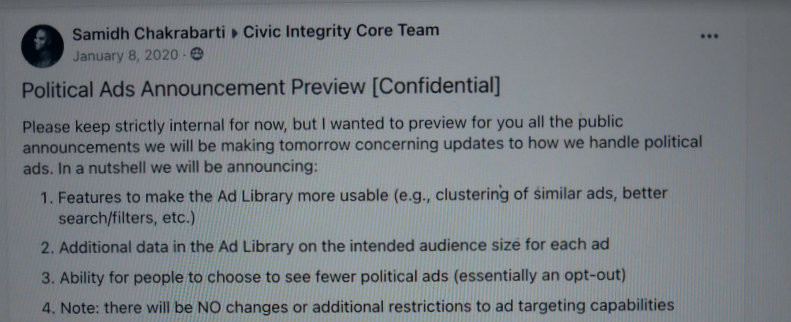For a company that makes upwards of 97% of its revenue off of targeted ads, Facebook’s never been the best at describing how those ad dollars actually get made in the first place. The platform’s privacy policies are a joke, its ad-focused public statements are deceptive at best, and its communication with advertisers themselves is much better. Even the company’s (arguably) biggest ads transparency effort to date — its public political ad library — has been widely panned for being an unsearchable, incomplete mess. And internally, it looks like some staffers largely agree.
The day before the company rolled out some minor changes to the ad library ahead of the 2020 election, for example, one high-ranking staffer sided with critics in Washington and elsewhere who claimed the company’s tweaks didn’t do enough to mitigate the harms that come with microtargeted political ads, according to an internal document released to Congress by whistleblower Frances Haugen.
More: Here are all the “Facebook Paper” documents we’ve published so far

“I know these changes don’t go as far as many of us would like to see in order to protect against the very real risk of abusive microtargeting,” wrote Samiddh Chakrabarti, who formerly headed the company’s Civic Integrity team on an internal Facebook forum on January 8, 2020.
The changes he was referring to were announced the next day by Facebook’s (now-former) director of project management, Rob Leathern. And saying that they “didn’t go far” enough is downright generous; at the time, the company said it would add beefed-up search parameters and the ability to see a given ad’s “potential reach.” In the following months, Leathern said, Facebook would be experimenting with tools to let people limit their exposure to political ads if they so chose.
Very notably absent from this lacklustre rollout was visibility into who’s being served these political ads in the first place — what populations are being targeted and how.
According to Chakrabarti’s “confidential” internal message, the reasons Facebook leadership (he cites a “Mark” by name, presumably referring to CEO Mark Zuckerberg) chose not to further limit its political ad targeting because doing so “would result in far too great collateral damage to get-out-the-vote campaigns and other advocacy campaigns who use these features for vital political mobilisation.” Considering how many of these stakeholders allegedly lean pretty conservative, and have for years, it’s not surprising that Facebook’s higher-ups would try to stymie anything that would bring their dirtiest tactics to light.
Facebook — now known as Meta — did not yet respond to a request for comment about this memo.
Months later after the political ad library’s release, when a team of independent academic researchers out of New York University would try to run their own independent studies into how the platform’s political ads were targeted, Facebook threatened the team with “enforcement action.” The company then shut down the personal accounts of these NYU researchers this past summer, claiming that the research amounted to “unauthorised data scraping.”
Chakrabarti hasn’t responded to our request for comment, but even he acknowledged that he “would have liked to see additional restrictions on ad targeting for political ads or greater transparency into when microtargeting occurs.” Instead, if you go into the political ad library for any political candidate — like, say, former President Donald Trump — you’re shown pretty broad details about how the ad was targeted; it shows, for example, that an ad was seen more often by Facebookers in Pennsylvania or Florida, or that most of the people seeing them were over the age of 65. But when these ads can be targeted so minutely, researchers and reporters who scrutinize these platforms deserve a bit more insight into who’s seeing what.
